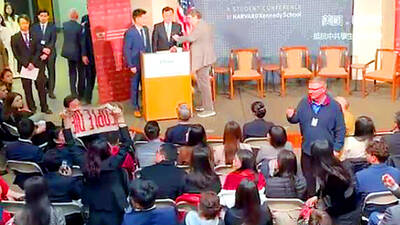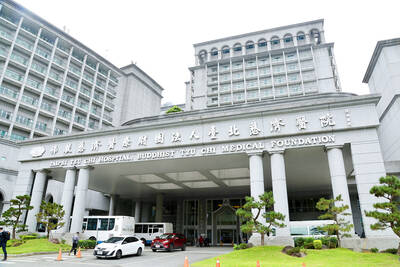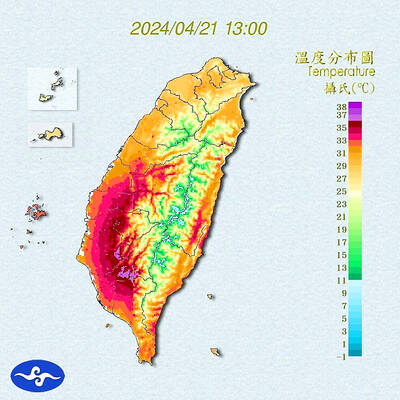Collaboration between the Confucian Chaoping Temple in Nantou County’s Puli Township (埔里) and Nantou-based National Chi Nan University has revealed that burning incense and joss paper, as well as setting off fireworks, is a large contributor to the amount of airborne particulate matter measuring 2.5 micrometers or less (PM2.5) in the township.
To provide the public with better monitoring of PM2.5 pollution in the township — which has significant PM2.5 pollution, especially in fall and winter — Day Rong-fuh (戴榮賦), a professor at the university’s Department of Information Management, spent the past two years researching and manufacturing miniature monitoring devices, which he has persuaded local temples to install.
The devices not only measure PM2.5 density in their surroundings, but also temperature, humidity and luminance, Day said, adding that they would be installed at 38 locations in the county.
The temple on Thursday installed two of the devices, which, with only 10 wands of incense in a burner, showed that PM2.5 emissions had reached the “purple” level.
The Environmental Protection Administration uses a four-color system to indicate PM2.5 concentrations, with “purple” being the most severe, corresponding to PM2.5 concentrations in excess of 71 micrograms per cubic meter.
Temple officials said one monitor was placed next to incense burners, where it signaled “yellow” — about 36 micrograms per cubic meter — with no wind, adding that when the wind blew incense smoke directly at the monitor, it immediately spiked to “purple.”
The device’s purpose is to remind temple officials and worshipers of the level of pollution, allowing them to make adjustments accordingly, Day said, adding that possible solutions include not using incense, or giving only one stick of incense to each group of visitors as a “token tribute.”
Chang Li-ya (張力亞), of the university’s General Education Center, said the monitors would help quantify air pollution.
At an event at Puli’s Dimu Temple, one monitor reported a spike of 400 to 500 micrograms per cubic meter when multiple worshipers lit wands of incense at the same time, Chang said, adding that at a “Bombing of Master Handan” event at Jenn Lann Temple in Taichung’s Dajia District (大甲), one monitor reported PM2.5 concentrations of 1,900 micrograms per cubic meter.
The Chaoping Temple’s management committee said that it has employed several methods to cut down on air pollution, such as periodically taking out incense handles, offering only one stick of incense to worshipers, stopping the practice of burning joss paper and turning on fans to help air circulation during events.
One worshiper, surnamed Lin (林), said that environmental protection is important, adding that if burning incense causes high levels of PM2.5 pollution, residents would vote to stop burning incense and just make the motions with their hands.
The deities will not care if we do not burn incense, as long as we are sincere, Lin said.
However, another worshiper, surnamed Kuo (郭), said that while temples could burn less incense, an incense wand is required to convey the wishes of mortals to deities.

A group of Taiwanese-American and Tibetan-American students at Harvard University on Saturday disrupted Chinese Ambassador to the US Xie Feng’s (謝鋒) speech at the school, accusing him of being responsible for numerous human rights violations. Four students — two Taiwanese Americans and two from Tibet — held up banners inside a conference hall where Xie was delivering a speech at the opening ceremony of the Harvard Kennedy School China Conference 2024. In a video clip provided by the Coalition of Students Resisting the CCP (Chinese Communist Party), Taiwanese-American Cosette Wu (吳亭樺) and Tibetan-American Tsering Yangchen are seen holding banners that together read:

UNAWARE: Many people sit for long hours every day and eat unhealthy foods, putting them at greater risk of developing one of the ‘three highs,’ an expert said More than 30 percent of adults aged 40 or older who underwent a government-funded health exam were unaware they had at least one of the “three highs” — high blood pressure, high blood lipids or high blood sugar, the Health Promotion Administration (HPA) said yesterday. Among adults aged 40 or older who said they did not have any of the “three highs” before taking the health exam, more than 30 percent were found to have at least one of them, Adult Preventive Health Examination Service data from 2022 showed. People with long-term medical conditions such as hypertension or diabetes usually do not

POLICE INVESTIGATING: A man said he quit his job as a nurse at Taipei Tzu Chi Hospital as he had been ‘disgusted’ by the behavior of his colleagues A man yesterday morning wrote online that he had witnessed nurses taking photographs and touching anesthetized patients inappropriately in Taipei Tzu Chi Hospital’s operating theaters. The man surnamed Huang (黃) wrote on the Professional Technology Temple bulletin board that during his six-month stint as a nurse at the hospital, he had seen nurses taking pictures of patients, including of their private parts, after they were anesthetized. Some nurses had also touched patients inappropriately and children were among those photographed, he said. Huang said this “disgusted” him “so much” that “he felt the need to reveal these unethical acts in the operating theater

Heat advisories were in effect for nine administrative regions yesterday afternoon as warm southwesterly winds pushed temperatures above 38°C in parts of southern Taiwan, the Central Weather Administration (CWA) said. As of 3:30pm yesterday, Tainan’s Yujing District (玉井) had recorded the day’s highest temperature of 39.7°C, though the measurement will not be included in Taiwan’s official heat records since Yujing is an automatic rather than manually operated weather station, the CWA said. Highs recorded in other areas were 38.7°C in Kaohsiung’s Neimen District (內門), 38.2°C in Chiayi City and 38.1°C in Pingtung’s Sandimen Township (三地門), CWA data showed. The spell of scorching